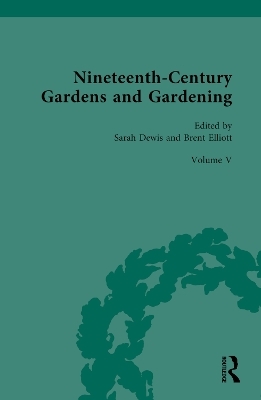
Nineteenth-Century Gardens and Gardening
Routledge (Verlag)
978-0-367-18859-7 (ISBN)
This volume is the fifth of a six volume collection that brings together primary sources on gardens and gardening across the long nineteenth-century. Economic expansion, empire, the growth of the middle classes and suburbia, the changing role of women and the professionalisation of gardening, alongside industrialisation and the development of leisure and mass markets were all elements that contributed to and were influenced by the evolution of gardens. It is a subject that is both global and multidisciplinary and this set provides the reader with a variety of ways in which to read gardens – through recognition of how they were conceived and experienced as they developed. Material is primarily derived from Britain, with Europe, USA, Australia, India, China and Japan also featuring, and sources include the gardening press, the broader press, government papers, book excerpts and some previously unpublished material.
Dr Sarah Dewis followed a career in graphic design at the BBC and completed her doctorate at Birkbeck University of London. She contributed to The Lure of Illustration in Nineteenth Centiury Picture and Press (2009) and to the Dictionary of Nineteenth Century Journalism in Great Britain and Ireland (2009). She has lectured at the Institute of Historical Research (2014) and is the author of The Loudons and the Gardening Press (2014). Dr Brent Elliott was Librarian of the Royal Horticultural Society from 1982 to 2007, and since 2007 has been the Society’s Historian. He is the author of Victorian Gardens (1986), Treasures of the Royal Horticultural Society (1994), The Country House Garden (1995), Flora: an Illustrated History of the Garden Flower (2001), The Royal Horticultural Society: a History 1804-2004 (2004), and most recently, RHS Chelsea Flower Show: a Centenary Celebration (2013). A former editor of Garden History, he is currently editor of Occasional Papers from the RHS Lindley Library. He is a member of the Victorian Society’s Buildings Committee, and for 25 years was a member of the Historic Parks and Gardens Committee/Panel of English Heritage.
Volume 5 – Garden Design
Acknowledgments
General Introduction
Introduction to volume 5
Part 1 - The Garden as a Work of Art
a) General Theory
1. Humphry Repton, illustrated motto from Designs for the Pavillon at Brighton (1822)
2. Sigismund Gottfried Dittmar, ‘The Artistic Beauty of Garden Culture: A Theoretical Essay’ [‘Der Kunstschönen der Gartencultur’], Neues Allgemeines Garten-Magazin, part II, vol. 1 (1825), pp. 251-262
3. John Claudius Loudon, Suburban Gardener and Villa Companion (1838), pp. 136-142
4. Ramsay Richard Reinagle, ‘Original Beauty in Lines and Forms’, Gardener’s Magazine, vol. 3 (1827), pp. 247-252
5. James Main, ‘Remarks on the Question, whether the Architect or the Landscape Gardener should be Employed First’, Gardener’s Magazine, vol. 8 (1832), pp. 673-677
6. William Henry Leeds, ‘Landscape and Ornamental Gardening’, Foreign Quarterly Review, vol. 16 (1835), pp. 154-159
7. Anon., ‘On the Arrangement of Ornamental Plants’, Florist’s Journal (1840), pp. 177-180
8. Donald Beaton, ‘How to Proceed in the Arrangement of Pleasure-grounds’, Cottage Gardener, vol. 23 (1860), pp. 249-251
9. Edward Kemp, ‘Biddulph Grange’, Gardeners’ Chronicle (1856), p. 679
10. John Dando Sedding, Garden-craft Old and New (1890), pp. 2-5, 6-9, 13-14
11. Thomas Mawson, The Art and Craft of Garden-Making (1900), pp. 1-3, 5
b) …and in Practice
12. Thomas Love Peacock, extract from Headlong Hall (1816)
13. Robert Plumer Ward, extract from De Clifford, or the Constant Man (1841), pp. 231-240
14. Edward Kemp, How to Lay out a Garden, 3rd ed. (1864), pp. 28-33
15. Gustave Flaubert, Bouvard et Pécuchet (1881) [1936 transl.], pp. 59-62, 65-66
16. Alfred Austin, The Garden that I Love (1892), pp. 14-15, 56-57, 114-117
Part 2. General Principles of Garden Design
a) The Landscape Garden
17. Humphry Repton, Observations on the Theory and Practice of Landscape Gardening (1805), pp. 13-14, 108-110
18. Thomas Shepherd, Lectures on Landscape Gardening in Australia (1836), pp. 17-30
19. Robert Glendinning, ‘On the Introduction of Single Trees into Park Scenery’, Gardener’s Magazine, vol. 12 (1836), pp. 513-515
20. Robert Henry Cheney, excerpt from ‘Landscape Gardening’, Quarterly Review, vol. 98 (1855), pp. 206-212
21. Hermann Graf von Pückler-Muskau, ‘Enclosure’, Andeutungen über Landschaftsgärtnerei (1834) [transl. 2014 as Hints on Landscape Gardening], pp. 36-38.
22. Carl August Sckell, ‘Observations on the Landscape Gardening of Germany, as Compared with that of England’, Gardener’s Magazine, vol. 10 (1834), pp. 197-200
23. MM. Denis & Renouard, ‘Landscape Garden Containing a Symmetrical Garden’ (Jardin Paysager Renfermant un Jardin Symmetrique), Belgique Horticole, vol. 3 (1853), p. 228
24. J. C. Loudon, Suburban Gardener and Villa Companion (1838), pp. 159-169
25. James Fenimore Cooper, extracts from ‘American and European Scenery Compared’, in The Home Book of the Picturesque (1852), pp. 52-54, 58-60, 64
26. Andrew Jackson Downing, Treatise on the Theory and Practice of Landscape Gardening (1841), pp. 28-43
27. Joshua Major, The Theory and Practice of Landscape Gardening (1852), pp. 6-8, 18-24
28. Mungo Temple, ‘Marnock’s Maxims’, Gardeners’ Chronicle (1890), p. 20
29. H. E. Milner, The Art and Practice of Landscape Gardening (1890), pp. 1-8
30. Thomas Mawson, ‘Planting for Landscape Effect’, The Art and Craft of Garden-Making (1900), pp. 113-118, 121-123
b) The Architectural Garden and Historical Revivals
31. Humphry Repton, extract from Enquiry into the Changes of Taste in Landscape Gardening (1806), pp. 31-41
32. Humphry Repton, extract from Fragments on the Theory and Practice of Landscape Gardening (1816), pp. 40-41, 48; 137-147
33. John Claudius Loudon, introduction to his edition of The Landscape Gardening and Landscape Architecture of the Late Humphry Repton Esq. (1840), pp. v-x
34. Charles M’Intosh, The Flower Garden (1838), pp. 9-20
35. John Lindley, ‘On the Arrangement of Gardens and Pleasure-Grounds in the Elizabethan Age’, from Journal of the Horticultural Society, vol. 3 (1848), pp. 1-2
36. Robert Glendinning, ‘Elvaston Castle, the Seat of the Earl of Harrington’, Gardeners’ Chronicle (1849), p. 773
37. Donald Beaton, ‘Shrubland Park’, Cottage Gardener, vol. 16 (1856), pp. 452-453, 469-470
38. Edward Kemp, How to Lay out a Garden, 3rd ed. (1864), p. 91-95, 99, 110-113
39. F. G. Stephens, ‘Horticultural Society’s New Gardens’, Athenaeum, 16 March 1861, pp. 362-363, William Hepworth Dixon, ‘Our Weekly Gossip’, Athenaeum, 8 June 1861, p. 766, F. G. Stephens, ‘Horticultural Gardens – Kensington’, Athenaeum, 19 October 1861, p. 509
40. John Lindley and William Andrews Nesfield, leader from Gardeners’ Chronicle, 1862, pp. 379-380
41. Adolphe Alphand, Introduction [incorporating a history of gardening, excerpts from which follow), Les Promenades de Paris (1867-73), pp. xv-xxxi
42. Eleanor Vere Boyle, extracts from Days and Hours in a Garden (1884), pp. 3-13
43 John Dando Sedding, extract from Garden-craft Old and New (1890), pp. 179-182
44. Reginald Blomfield, extract from The Formal Garden in England (1891), pp. 1-7, 11-13
45. William Robinson, extract Garden Design and Architects’ Gardens (1892), pp. 25-30
46. Lothar Abel, ‘The Artistic Aspirations of the Gardeners of our Century’ [‘Die Kunst Bestrehungen in der Gärtner unseres Jahrhunderts’], Wiener Illustrirte Garten-Zeitung, vol. 17 (1892), pp. 325-333
Bibliography of Sources
List of Press Sources
Bibliography of works cited
Index
| Erscheinungsdatum | 10.07.2024 |
|---|---|
| Zusatzinfo | 42 Halftones, black and white |
| Verlagsort | London |
| Sprache | englisch |
| Maße | 156 x 234 mm |
| Gewicht | 707 g |
| Themenwelt | Sachbuch/Ratgeber ► Natur / Technik ► Garten |
| Geisteswissenschaften ► Geschichte ► Regional- / Ländergeschichte | |
| Geschichte ► Teilgebiete der Geschichte ► Kulturgeschichte | |
| Geschichte ► Teilgebiete der Geschichte ► Religionsgeschichte | |
| ISBN-10 | 0-367-18859-7 / 0367188597 |
| ISBN-13 | 978-0-367-18859-7 / 9780367188597 |
| Zustand | Neuware |
| Informationen gemäß Produktsicherheitsverordnung (GPSR) | |
| Haben Sie eine Frage zum Produkt? |
aus dem Bereich


